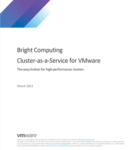<SPONSORED CONTENT> This whitepaper, “Bright Computing Cluster as a Service for VMware,” from Bright Computing discusses how through advanced automation, Bright Cluster Manager eliminates the complexity of building and managing high-performance Linux clusters, enabling greater organizational efficiency and flexibility. And now, Bright Cluster Manager also supports clusters in VMware vSphere—and goes one step further to […]
Supermicro Powers Red Hat Hyperconverged Infrastructure for Virtualization
Today Supermicro introduced multiple systems tailored to work with a leading open, hyperconverged software offering, Red Hat Hyperconverged Infrastructure. Supermicro collaborated with Red Hat to develop advanced configurations based on industry-leading Supermicro servers featuring the latest technologies. These systems, available now, give customers new options when architecting infrastructure.
Agile HPC with VMware Cloud Foundation & UberCloud
Thomas Francis from the UberCloud and Mohan Potheri from VMware gave this talk at the Stanford HPC Conference. “In this solution we combine the capabilities of the VMware platform, with the solution provided by UberCloud which leverages the automation capabilities of Terraform with the unique packaging and distributing capabilities of docker-based HPC containers to dynamically deploy HPC applications on the vSphere platform.”
Podcast: Accelerating the Adoption of Container Technologies for Exascale Computing
In this Let’s Talk Exascale podcast, Andrew Younge from Sandia National Laboratories describes the new SuperContainers project, which aims to deliver containers and virtualization technologies for productivity, portability, and performance on the first exascale computing machines are planned for 2021. “Essentially, containers allow you to encompass your entire environment in a simple and reproducible way,” says Younge. “So not only do I have my container image that has my application and my entire software stack with it, I also have a manifest for how I got there. That’s a really important notion for many people.”
Bright Computing adds more than 100 new customers In 2019
Commercial enterprises, research universities and government agencies are turning to Bright Cluster Manager to reduce complexity and increase flexibility of their high-performance clusters. Along these lines, the company just announced the addition of more than 100 organizations to its client list in 2019, including AMD, Caterpillar, GlaxoSmithKline, Saab, Northrop Grumman, Trek Bicycles, Samsung, General Dynamics, Lockheed Martin and BAE, as well as 19 government agencies and 28 leading universities.
Sylabs releases SingularityPRO 3.5
Today Sylabs announced the release of SingularityPRO 3.5, a popular container platform for HPC, supercomputing, and AI. “SingularityPRO 3.5, released January 21st, 2020, brings exciting new features to the long-term professionally supported version of the container platform. Based on the open source 3.5.2 release, SingularityPRO will receive security and bug fixes for 3 years, making it an ideal solution for the business-driven needs of enterprise customers containerizing their compute workloads.”
VMware to add BitFusion GPU Virtualization to HPC Capabilities
In this video from SC19, Mohan Potheri from VMware describes how virtualization makes HPC users more productive. “High Performance Computing workloads are forecasted to be one of the fastest-growing workload types through 2020. With VMware, you can capture the benefits of virtualization for HPC workloads while delivering performance that is comparable to bare-metal. Our approach to virtualizing HPC adds a level of flexibility, operational efficiency, agility and security that cannot be achieved in bare-metal environments—enabling faster time to insights and discovery.”
Addressing the Scientific Reproducibility Crisis with Singularity
Michael Bauer from Sylabs gave this talk at the Perth HPC Conference. “Containers provide the means to encapsulate an application, its dependencies, data, and configurations, that allows for full mobility and reproducibility of the software stack. Containers have disrupted the Linux scene within the last few years because they have created a paradigm shift in what it means to package up and move applications and data.”













